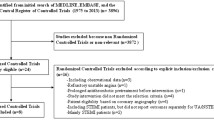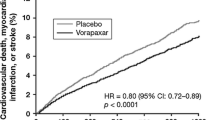Abstract
Patients presenting with unstable angina pectoris or non-Q-wave myocardial infarction (MI), if treated inadequately, are at a high risk of MI and subsequent mortality. The use of intravenous small molecule glycoprotein IIb/IIIa inhibitors along with standard therapeutic management options improves outcome. Since the publication of the Thrombolysis in Myocardial Ischemia IIIB, Veterans Affairs Non-Q-Wave Infarction Strategies In-Hospital (VANQWISH) and Fragmin and Fast Revascularization during Instability in Coronary artery disease II (FRISC II) studies, there is great debate about the advantages of following an early ‘invasive’ treatment option with coronary angiography and revascularization after initial medical therapy compared with the ‘conservative’ approach, where angiography is reserved for those who remain symptomatic. The Treat angina with Aggrastat and determine Cost of Therapy with an Invasive or Conservative Strategy — Thrombolysis in Myocardial Infarction 18 (TACTICS-TIMI 18) study has helped to resolve some of the controversies since it was designed with more current medical (early and routine use of tirofiban) and revascularization (use of Stents during percutaneous coronary interventions) options as part of the invasive treatment protocol. This study indicated that an early invasive strategy in risk stratified patients combined with early use of tirofiban with standard medical therapy significantly improves outcome and appears well tolerated.


Similar content being viewed by others
References
Braunwald E, Antman EM, Beasley JW, et al. ACC/AHA guidelines for the management of patients with unstable angina and non-ST-segment elevation myocardial infarction: a report of the American College of Cardiology/American Heart Association Task Force on Practice Guidelines (Committee on the Management of Patients with Unstable Angina). J Am Coll Cardiol 2000; 36: 970–2
Collinson J, Flather MD, Fox KAA, et al. Clinical outcomes, risk stratification and practice patterns of Unstable angina and myocardial infarction without ST elevation: Prospective Registry of acute ischaemic syndromes in the UK (PRAIS-UK). Eur Heart J 2000; 21: 1450–7
Vorchheimer D, Badimon JJ, Fuster V. Platelet Glycoprotein IIb/IIIa receptor Antagonists in Cardiovascular Disease. JAMA1999; 281: 1407–14
Manoharan G, Maynard SJ, Adgey AAJ. The therapeutic use of glycoprotein IIb/IIIa inhibitors in acute coronary syndromes. Expert Opin Investig Drugs 1999; 8(5): 555–66
Lefkovits J, Plow EF, Topol EJ. Platelet glycoprotein IIb/IIIa receptors in cardiovascular medicine. N Engl J Med 1995; 332: 1553–9
Coller BS. Blockade of platelet GP IIb/IIIa receptors as an antithrombotic strategy. Circulation 1995; 92: 2373–80
Lefkovits J, Topol EJ. Platelet glycoprotein IIb/IIIa receptor antagonists in coronary artery disease. Eur Heart J 1996; 17: 9–18
Unstable angina: diagnosis and management. Clinical practice guidelines. US Department of Health and Human Services. AHCPR publication no. 94-0602, 1994
Fragmin-During-Instability-In-Coronary-Artery-Disease Study Group. Low molecular weight heparin during instability in coronary artery disease. Lancet 1996; 347: 561–8
Kaul S, Shah PK. Low molecular weight heparin in acute coronary syndrome: Evidence for superior or equivalent efficacy compared with unfractionated heparin? J Am Coll Cardiol 2000; 35(7): 1699–712
Campbell RW, Wallentin L, Verheugt FW, et al. Management strategies for a better outcome in unstable coronary artery disease. Clin Cardiol 1998; 21: 314–22
Theroux P, Fuster V. Acute coronary syndromes unstable angina and non-Q-wave myocardial infarction. Circulation 1998; 97: 1195–206
Manoharan G, Adgey AAJ. Glycoprotein IIb/IIIa Inhibitors and Acute Coronary Syndromes: summary report of the full submission to NICE, and beyond. Heart 2001; 86: 259–61
The TIMI IIIB Investigators. Effects of tissue Plasminogen activator and a comparison of early invasive and conservative strategies in unstable angina and non-Q-wave myocardial infarction. Circulation 1994; 89: 1545–56
Anderson HV, Cannon CP, Stone PH, et al. For the TIMI IIIB Investigators. One year results of the thrombolysis in myocardial infarction (TIMI) IIIB Trial. J Am Coll Cardiol 1995; 26: 1643–50
The TIMI Research Group. Immediate versus delayed catheterisation and angioplasty following thrombolytic therapy for acute myocardial infarction. TIMI IIA results. JAMA 1988; 260: 2849–58
Boden WE, O’Rourke RA, Crawford MH, et al. For the VANQWISH Trial Investigators. Outcomes in patients with acute non-Q-wave myocardial infarction randomly assigned to an invasive as compared with a conservative management strategy. N Engl J Med 1998; 338(25): 1785–92
Ferry DR, O’Rourke RA, Blaustein AS, et al. Design and baseline characteristics of the Veterans Affairs Non-Q-Wave Infarction Strategies In Hospital (VANQWISH) trial. J Am Coll Cardiol 1998; 31: 312–20
The FRagmin and Fast Revascularisation during Instability in Coronary artery disease Investigators. Invasive compared with non-invasive treatment in unstable coronary-artery disease: FRISC II prospective randomised multicentre study. Lancet 1999; 354: 708-15
Wallentin L, Lagerqvist B, Husted S, et al. For the FRISC II Investigators. Outcome at 1 year after an invasive compared with a non-invasive strategy in unstable coronary-artery disease: the FRISC II invasive randomised trial. Lancet 2000; 356: 9–16
Cannon CP, Weintraub WS, Demopoulos LA, et al. Comparison of early invasive and conservative strategies in patients with unstable coronary syndromes treated with the glycoprotein IIb/IIIa inhibitor tirofiban. N Engl J Med 2001; 344: 1879–87
Gibson M, Murphy SA, Weisberg S, et al. Early initiation of tirofiban therapy before percutaneous intervention is associated with improved flow and tissue level perfusion: a TACTICS-TIMI 18 substudy [abstract]. Circulation 2001; 104 Suppl. II: II–548
Gibson M, Murphy SA, Pai R, et al. Elevations in troponin T are associated with abnormal tissue level perfusion: a TACTICS-TIMI 18 substudy [abstract]. Circulation 2001; 104 Suppl. II: II–708
Antman EM, Cohen M, Bernink PJ, et al. The TIMI risk score for unstable angina/non-ST elevation MI: a method for prognostication and therapeutic decision making. JAMA 2000; 284: 835–42
Bach RG, Cannon CP, Dibattiste PM, et al. Enhanced benefit of early invasive management of acute coronary syndromes in the elderly: results from the TACTICS-TIMI 18 [abstract]. Circulation 2001; 104 Suppl. II: II–548
Sadanandan S, Cannon CP, Dibattiste PM, et al. Outcomes of patients with spontaneous versus post PCI CK-MB elevation: data from TACTICS-TIMI 18 trial [abstract]. Circulation 2001; 104 Suppl. II: II–697
Kugelmass AD, Sadanandan S, Cannon CP, et al. Early invasive strategy improves outcomes in acute coronary syndrome patients with prior CABG: results from TACTICS-TIMI 18 [abstract]. Circulation 2001; 104 Suppl. II: II–548
Heidenreich PA, Alloggiamento T, Melsop K, et al. The prognostic value of troponin in patients with non-ST elevation acute coronary syndromes: a metaanalysis. J Am Coll Cardiol 2001; 38: 478–85
Bertrand ME, Simoons ML, Fox KAA, et al. Management of acute coronary syndromes: acute coronary syndromes without persistent ST segment elevation. Eur Heart J 2000; 21: 1406–32
Braunwald E, Antman EM, Beasley JW, et al. ACC/AHA Guidelines for the management of patients with unstable angina and non-ST-segment elevation myocardial infarction: executive summary and recommendations. J Am Coll Cardiol 2000; 36: 970–1062
Braunwald E, Antman EM, Beasley JW, et al. ACC/AHA Guidelines for the management of patients with unstable angina and non-ST-segment elevation myocardial infarction: executive summary and recommendations. Circulation 2000; 102: 1193–209
Hamm CW, Bertrand M, Braunwald E. Acute coronary syndrome without ST elevation: implementation of new guidelines. Lancet2001; 358: 1533–8
Author information
Authors and Affiliations
Corresponding author
Rights and permissions
About this article
Cite this article
Manoharan, G., Adgey, A.A.J. Current Management of Unstable Angina. Am J Cordiovosc Drugs 2, 237–243 (2002). https://doi.org/10.2165/00129784-200202040-00003
Published:
Issue Date:
DOI: https://doi.org/10.2165/00129784-200202040-00003




